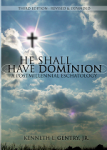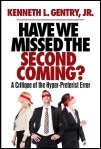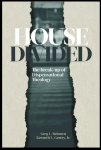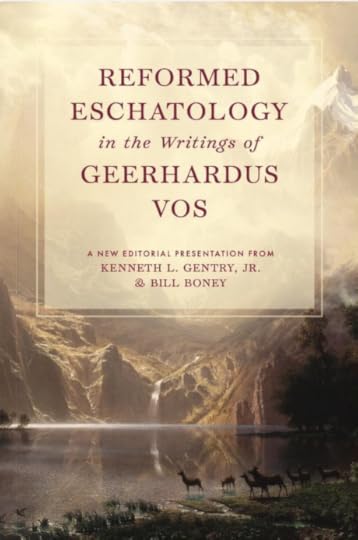PHYSICAL RESURRECTION AND NEW CREATION
 PMW 2024-090 by Kenneth L. Gentry, Jr.
PMW 2024-090 by Kenneth L. Gentry, Jr.
A Brief Testimony
When I enrolled at Reformed Theological Seminary in Jackson, Mississippi, I had just converted out of dispensationalism. I had been thoroughly schooled in dispensationalism at Tennessee Temple College in Chattanooga, Tennessee. Upon graduating from Temple with a degree in Biblical Studies, I enrolled in the M.Div. program at another dispensational institution, Grace Theological Seminary in Winona Lake, Indiana.
While at Grace I stumbled onto O. T. Allis’ book Prophecy and the Church. This book led me out of dispensationalism and toward a Reformed eschatology. My transformation was not complete upon reading Allis, however. That completion would not be reached until I had studied for two years at Reformed Seminary, to which I transferred after two years at Grace.
Introducing Ladd
While at RTS I was somewhat surprised that in a NT Theology course we were to read George E. Ladd’s A Theology of the New Testament. Ladd, of course, was premillennial (though vehemently opposed to dispensationalism). Despite his premillennialism, his work has much to commend it to Reformed Christians. In fact, as I am researching a book on the two-age doctrine of redemptive history, I once again am finding Ladd to be quite helpful. And he even cites Geerhardus Vos, whose work is essential for Reformed theology today.

He Shall Have Dominion
(paperback by Kenneth Gentry)
A classic, thorough explanation and defense of postmillennialism (600+ pages). Complete with several chapters answering specific objections.
See more study materials at: www.KennethGentry.com
Some Ladd observations
I have now completed re-reading Ladd’s 1964 work, The Presence of the Future. This remarkable book is very helpful for explaining the two-age doctrine and its sister position of the “now by not yet” view of NT revelation. The two-age doctrine presents the structure of redemptive history as contrasting “this age” (the fallen age under the first Adam, i.e., history since the fall) with “the coming age” (the perfect, consummate new creation order under the second Adam). Though these two ages are distinguished, they overlap in redemptive history beginning with the ministry of Christ and continuing until his second coming. This overlap era is known as “the last days.”
In this last-days overlap we can taste of the good things of “the age to come” even though we cannot experience them to their fullest extent. We live in the time of the “now but not yet.” That is, we are now sanctified, though we await complete, full sanctification (body and soul) in the consummate order after Christ returns. We are now justified, although we await complete, full justification in the consummate order after the final judgment. We are now spiritually resurrected, but await our future bodily resurrection when Christ returns to effect the global resurrection of the dead. We are now in the spiritual new creation, although we await the final, consummate material recreation with the establishing of the consummate order. On and on I could go with illustrations. This is what we mean by the “now but not yet” understanding of New Testament revelation.
Have We Missed the Second Coming:
A Critique of the Hyper-preterist Error
by Ken Gentry
This book offers a brief introduction, summary, and critique of Hyper-preterism. Don’t let your church and Christian friends be blindfolded to this new error. To be forewarned is to be forearmed.
For more Christian educational materials: www.KennethGentry.com
Now back to why I am writing this post. In Ladd’s The Presence of the Future I have found many nicely put declarations regarding the two-ages and the “now but not yet” structure of redemptive history. The present article is not intending to prove these twin views. Rather it will simply show how they serve well in historic Christian orthodoxy as we come to understand the fullness of our salvation.
So, I will simply cite a few sentences from Ladd in order to whet your appetite for considering this fine work, and for preparing you for my postmillennial book that I am writing on the two-age doctrine. Though Ladd argues for premillennialism in this work, those arguments can be easily adapted by postmillennialists who also believe God’s glory is to be manifested in history. So, allow me to cite a few of Ladd’s helpful comments that give proper attention to the material order which God created for us.
On p. 59 Ladd states:
“the biblical idea of redemption always includes the earth. Hebrew thought saw an essential unity between man and nature…. The Old Testament nowhere holds forth the hope of bodiless, non-material, purely ‘spiritual’ redemption as did Greek thought. The earth is the divinely ordained scene of human existence.”
If only the new Gnostics among us could understand that God created us as material beings to be distinguished from angels who are spiritual beings! A part of the failure of this new Gnosticism is due to its not being able to comprehend the two-age structure of redemptive history.
House Divided: The Break-up of Dispensational Theology By Greg Bahnsen and Ken Gentry
By Greg Bahnsen and Ken Gentry
This book presents and defends Christian Reconstruction theology, particularly theonomic ethics and postmillennial eschatology. It does to by responding to dispensationalism’s social and exegetical theology.
For more educational materials: www. KennethGentry.com
On p. 61 Ladd writes:
“The dissolution of the natural order is not designed to accomplish its destruction but to make way for a new perfect order arising out of the old imperfect one…. The final visitation of God will mean the redemption of the world; for a redeemed earth is the scene of the future Kingdom of God.”
He makes this statement while discussing the several “day of the Lord” events that appear in history. They are all related and they all point to the final “day of the Lord” that arrives with the return of Christ to establish the consummate new order.
On p. 63 Ladd continues:
“Salvation for man does not mean deliverance from creaturehood, for it not an evil thing but an essential and permanent element of man’s true being. Salvation does not mean escape from bodily, creaturely existence. On the contrary, ultimate redemption will mean the redemption of the whole man. For this reason, the resurrection of the body is an integral part of the biblical hope. The corollary of this is that creation in its entirety must share in the blessings of redemption. There is no Greek dualism or Gnosticism in the Old Testament hope.”
Well put! Even for a premillennialist. I highly recommend this older work for much that is good in it.
Reformed Eschatology in the Writings of Geerhardus Vos
Ed. by Ken Gentry and Bill Boney
This is a collection of several key eschatological studies by the renowned Reformed theologian Geehardus Vos. We have modernized Vos’ grammar and syntax and updated his layout style according to modern publishing conventions (shorter sentences and paragraphs). We did this without changing any of Vos’ arguments.
For more information on this new Vos work or to order it, see:
https://www.kennethgentry.com/reformed-eschatology-in-the-writings-of-geerhardus-vos/
Kenneth L. Gentry Jr.'s Blog
- Kenneth L. Gentry Jr.'s profile
- 85 followers



